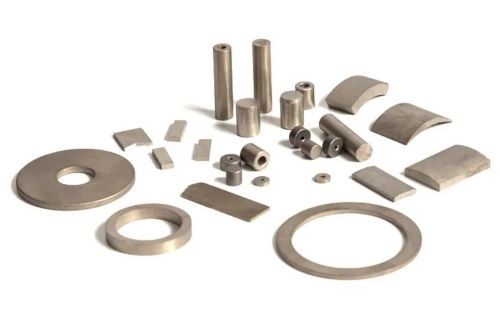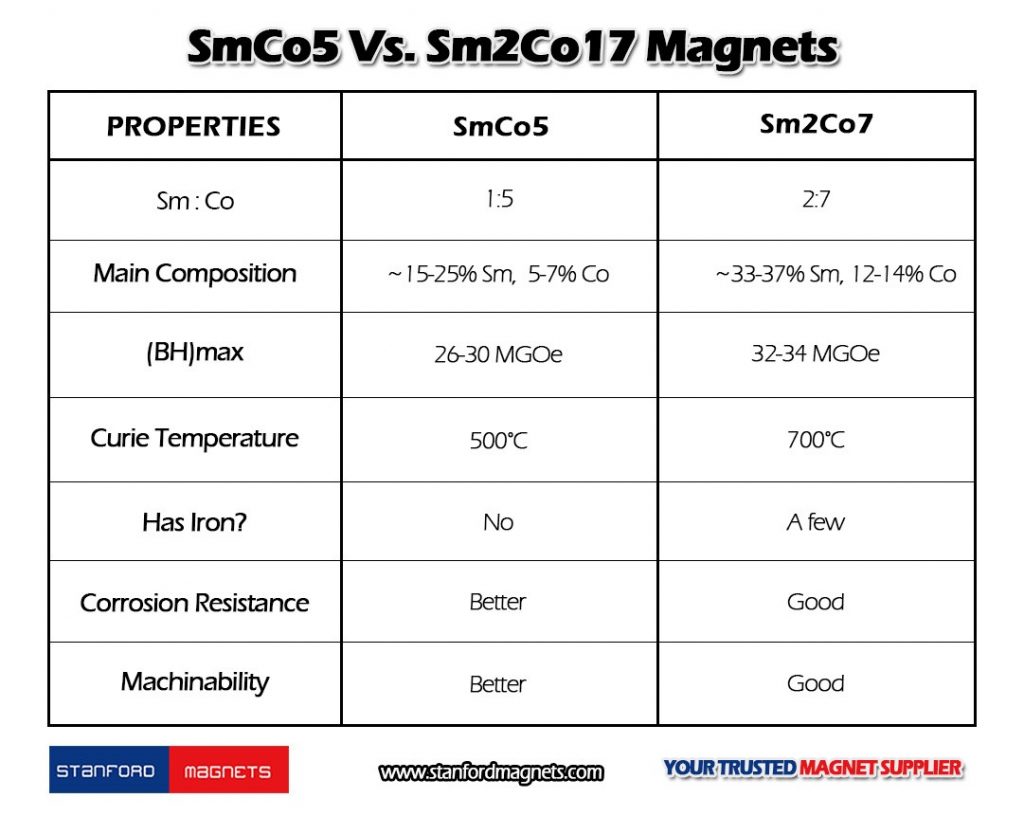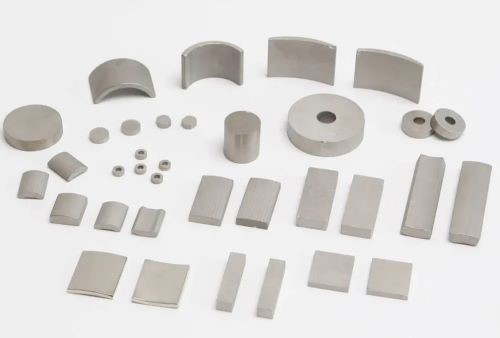Two Grades of Samarium Cobalt Magnets: SmCo5 & Sm2Co17
Introduction
Samarium cobalt (SmCo) magnets are a kind of rare-earth magnets with high magnetic strength, excellent temperature stability, and resistance to demagnetization. Thus, they are ideal for use in numerous applications, including motors, sensors, and magnetic bearings. In this article, we are going to introduce two main grades of samarium cobalt magnets—SmCo5 and Sm2Co17. Hope that you can have a better understanding of the types and advantages of samarium cobalt magnets.
Two Grades of Samarium Cobalt Magnets
Samarium cobalt magnets are a kind of powerful permanent magnets with high energy, great thermal stability, and high magnetic coercivity. These strong magnets entered the market in the 1970s for their unique features and gained popularity thereafter. They can be roughly divided into two series: SmCo5 and Sm2Co17. Their differences are listed below.

Figure 1. Samarium Cobalt Magnets
--SmCo5 Magnets
SmCo5 magnets are the first generation of samarium cobalt magnets. The numbers in the grade designation refer to the ratio of samarium to cobalt in the magnet composition. The 1:5 grades have one samarium atom coupled with five cobalt atoms. They contain approximately 15-25% samarium, 5-7% cobalt, and small amounts of other rare earth metals such as praseodymium and neodymium. Such magnets have a maximum energy product (BH)max of around 26-30 MGOe (mega gauss-oersteds). They are suitable for use in high-temperature applications up to 350°C, while their curie temperature is about 500°C. Additionally, the 1:5 series excels at better corrosion resistance and machinability because such samarium cobalt magnets do not possess any iron. Meanwhile, Sm2Co17 magnets might have few iron contents, so extra corrosion protection is required.
--Sm2Co17 Magnets
Gradually, Sm2Co17 magnets took the place of SmCo5 magnets because of their stronger energy and higher work temperatures. Such magnets have two samarium atoms along with seventeen cobalt atoms. The 2:17 grades of samarium cobalt magnets contain approximately 33-37% samarium and 12-14% cobalt, and you can find praseodymium and neodymium as well. These magnets have a maximum energy product (BH)max of around 32-34 MGOe and are suitable for use in even higher-temperature applications up to 500°C. The curie temperature of Sm2Co17 is about 700°C. The contrast between the two types of magnets can be easily observed in the figure presented below.  Figure 2. SmCo5 Vs. Sm2Co17 Magnets
Figure 2. SmCo5 Vs. Sm2Co17 Magnets
Benefits of Samarium Cobalt Magnets
There are a dozen of subgroups of samarium cobalt magnets. All of them, including SmCo5 and Sm2Co17, share the following similarities.

Figure 3. Different Samarium Cobalt Magnets
--Magnetic Strength
Samarium cobalt (SmCo) magnets are one of the two most common rare-earth magnets, with Neodymium (Nd-Fe-B) magnets being the other one. SmCo magnets are the second-strongest magnets. Additionally, they stand out for the maximum energy products (BHmax) ranging from 16 megagauss-oersteds (MGOe) to 34 MGOe, making them suitable for most applications. Another advantage of SmCo magnets is their higher temperature ratings. Namely, they can work at higher temperatures of more than 300°C, while neodymium magnets could not.
--Thermal Stability
Samarium cobalt magnets remain stable at both high and low temperatures. Such magnets outperform all others if the temperature exceeds 150°C. The 2:17 series could bear temperatures up to 500°C, while the 1:5 grades have a slightly lower maximum work temperature of 350°C. The performance of both grades changes very little as temperature increases, which is much less than that of neodymium magnets. Besides, samarium cobalt magnets maintain their properties at temperatures as low as -273℃, so they are applied to cryogenic uses.
--Corrosion Resistance
Both series of samarium cobalt magnets are highly resistant to corrosion, and they are employed in harsh environments. Samarium cobalt magnets only have a fraction of iron and some rare earth elements, which are not prone to oxidation and corrosion. Yet, neodymium magnets have 60-70% of iron. Therefore, it is common to use uncoated samarium cobalt magnets, while extra coatings are needed for neodymium magnets.
--Demagnetization Resistance
In addition to their high magnetic strength and temperature stability, samarium cobalt magnets also have a relatively high coercivity, which means that they are more difficult to demagnetize than other types of magnets. This makes them ideal for use in applications where high magnetic stability is required, such as in sensors and magnetic bearings. Related reading: Everything You Need to Know About Samarium Cobalt Magnets
Conclusion
Overall, the choice between 1:5 and 2:17 samarium cobalt magnets will depend on the specific requirements of the application. The Sm2Co17 offers higher magnetic strength and temperature stability but is also more expensive. The SmCo5 is more corrosion-resistant and cost-effective, and it may be sufficient for many applications. A variety of quality samarium cobalt magnets are available at https://www.stanfordmagnets.com. They can suit a broad range of applications.
Stanford Magnets provides samarium cobalt magnets in the shape of blocks, discs, and rings. Customized products are also welcome. Send us an inquiry if you are interested.














